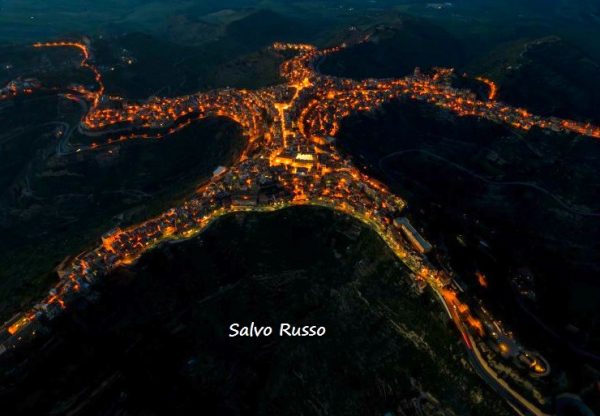Among the most original towns that surround the great volcano Etna, Centuripe (district of Enna) is definitely worth a visit. It is not located at the immediate foot of the mountain, but offers spectacular views anyway. Especially during the most powerful eruptions. And whether you see Mount Etna in action or not, Centuripe will not miss surprising you. Because this town hides many historical-artistic treasures. And it itself is a treasure, especially at night when it lights up and takes on a mysterious shape, visible only from above: that of a giant of light!
The “giant” of Centuripe
 photo by salvo russo
photo by salvo russo
The first pilots, passengers of scheduled flights, accidentally “discovered” it. Today everyone can see it, thanks to photos taken with drones. Centuripe has the strange and disturbing shape of a giant man. Its oldest core (the thorax), in fact, widens from the hill (the head) and branches out towards the four cardinal points, forming the arms and legs of a mythological being. Even if perhaps it is all just the result of chance. If you are inside the town you will not be able to see the “giant”. You will be an integral part of it yourself. But wherever you are on its “body”, you can admire all around the beauty of Sicilian nature and – on clear days – even the cone of Etna on the horizon.
Centuripe and its millenary history
Centuripe has always been inhabited, even if the first certain traces of the presence of man can be found in the Neolithic excavations that surround the hill. Certainly there was an inhabited area in the 6th century BC, populated mostly by Siculian people. It was the Greeks who founded a city called Kentòripa and exploited the territory . They did obtain a first clay industry and the manufacture of ceramic vases.
With the arrival of the Romans, in the 3rd century BC, Kentòripa became Centum Ripae (one hundred steep cliffs) due to very steep sides of the hill. In these centuries, the processing of ceramics and the agriculture gave Centuripe wealth and importance. It was proven that palaces and temples arose here and that Rome held this place and its inhabitants in high regard. This golden age was followed by dark and sad centuries. Centuripe was sacked several times, during the Arab domination, under the reign of Frederick II and again later, with the Angevins.
In the 15th century, following a violent earthquake, many populations of the coast moved to the old Centum Ripae, now abandoned, and rebuilt it with a new name: Centorbi. Between the 16th and 19th centuries, the town rose from its ruins and returned to have importance. After the unification of Italy for a period it was also a district’s capital. In 1862 it changed its name again to Centuripe. It was the unhappy protagonist of the ferocious battle of 2 and 3 August 1943, during the advance of the Allies against the German army in World War 2. Today the town lives mainly on agriculture, livestock and crafts.
Why come and visit Centuripe
Beyond the thrill of being “inside the giant” and the beauty of the views, Centuripe offers several interesting tourist itineraries. Its old core still bears the traces of the seventeenth-century rebirth, for example in the pink façade of the cathedral dedicated to the Immaculate Conception. Walking through the center you will find many other churches: St Giuseppe, St Gioacchino, the Announciation, the church of Purgatory …. Do not miss the interior of the church of the Crucifix, where the structure dating to the Roman era is still evident.
Along your walk, you may be surprised by the brick arches that support a local street, which are nothing more than the remains of the Roman Temple of the Augustales. The archaeological excavations of each era are the most exciting itinerary to follow in Centuripe. We point out, among others: the thermal remains of Acqua Amara, the ancient basins of Sorgiva Bagni, not far from the Greek necropolis. And again, the prehistoric necropolis of Contrada Casino, Contrada Cuba, of Borgo Carcaci, the ancient Greek-Roman clay furnaces, the ruins of the Roman town of Piano Pozzi.
Everything that you will not be able to see in the excavation sites is collected at the Archaeological Museum of Centuripe (vases, statues, objects, period tools).
On the road that connects Centuripe to Catania, passing over the Simeto river, the remains of a Roman bridge were also found. Those who want to see Centuripe and its beauties can also choose to visit it during Holy Easter Week. It is worth to see the ancient rites, which are renewed with immortal and evocative processions and traditions. We suggest you to come to Centuripe in spring or summer, so as to avoid bad weather and have the opportunity to admire the panorama of Etna.
How to get there
To get to Centuripe: the most direct way by car is the State Street 121 from Catania, or via the A19 motorway exiting at Catenanuova and continuing on the 121. Alternatively, those arriving from the south can take the State Street 192. The internal railway line which connects Catania and Palermo has a stop at Centuripe station. The nearest airport is Fontanarossa, Catania. (PHOTOS BY: Davide Mauro, above the title; and Salvo Russo)